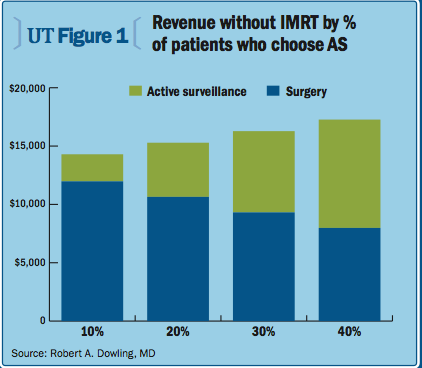Article
PCa surveillance: Impact on pay may surprise you
Robert A. Dowling, MD examines the possible impact of prostate cancer surveillance management approaches on a urology practice’s reimbursement and income.

Active surveillance is a term that should be familiar to urologists who manage patients with low-risk prostate cancer. Based on a contemporary-and evolving-understanding of the heterogeneity of prostate cancer and the natural history of the disease in certain patients with features of very low or low risk of progression, this management approach runs counter to many traditions of cancer care, training, experience, and culture in our surgical specialty.
In a previous article (“Prostate Ca surveillance: Overcoming obstacles”), I discussed some of the practical challenges of accurately identifying and tracking patients who are candidates for, or who are “on,” active surveillance. These challenges include an evolving definition of candidacy; a lack of endorsed guidelines and measures; an inability of clinical information systems to receive, store, or interpret this information in a consistent and computable manner; and disagreements about the precise protocol for surveillance of these patients.
In this article, I will examine the possible impact of this management approach on a urology practice’s reimbursement and income.
RELATED-Prostate Ca Surveillance: Overcoming obstacles
Model assesses costs of surveillance
Many might assume that referring a low-risk patient for active surveillance-“no treatment”-instead of definitive therapy might come at the expense of decreased revenue for the urologist in a fee-for-service model. To examine this hypothesis, it is necessary to create a model that contains some assumptions. Let’s make the following assumptions:
1. A urologist makes the new diagnosis of prostate cancer in 30 patients per year, and 50% of these patients have low- risk disease.
2. Of the low-risk patients who elect treatment, 50% choose surgery and 50% choose intensity-modulated radiation therapy (IMRT). The rest of the low-risk patients choose active surveillance.
3. The active surveillance protocol in this practice includes:
a. a confirmatory saturation biopsy
b. an annual surveillance biopsy
c. the same frequency and intensity of follow-up visits and lab testing as patients who had surgery or IMRT.
4. No patients in any category require additional therapy.
5. The reimbursement for the following services is based upon the 2014 Medicare Physician Fee Schedule, a conversion factor of $36, and the following relative value unit packages (author estimates only):
a. Surgery package 49.28 RVU
b. IMRT package 663.04 RVU
c. Active surveillance package 43 RVU
i. Saturation biopsy 12.48 RVU
1. Biopsy 10.41
2. Guidance 2.07
ii. Prostate biopsy 7.63 RVU
1. Ultrasound 2.62 RVU
2. Guidance 2.07 RVU
6. Payer mix: 100% Medicare
Next: Figures demonstrate revenue impact
More from Dr. Dowling
EHRs: Costly replacement or ‘disruptive innovation’?Could your EHR system put patients at risk?Bundled payments are coming; how to prepare
Based on these assumptions (or create your own), figures 1 and 2 demonstrate the revenue impact to the urology practice by proportion of patients who elect active surveillance. A practice that does not own an IMRT center would see about $1,000 per urologist per year in extra revenue for each 10% of patients who choose active surveillance. A practice that does own its own IMRT center would see a decline of about $18,000 per urologist per year for each 10% of patients who choose active surveillance.


A practice that does not own an IMRT center would see about $1,000 per urologist per year in extra revenue for each 10% of patients who choose active surveillance. A practice that does own its own IMRT center would see a decline of about $18,000 per urologist per year for each 10% of patients who choose active surveillance.
The impact in either direction might be larger with a payer mix where reimbursement is greater than 100% Medicare.
Bottom line: Referring a patient for an active surveillance program instead of definitive therapy may actually result in a modest increase in revenue for the majority of urologists who do not own IMRT centers. Even for those practices that do own IMRT centers, the financial impact amounts to less than one radiation referral per urologist per year for each 10% of patients who choose active surveillance in the model outlined above. Active surveillance is a management paradigm that keeps the urologist in charge of managing prostate cancer, and does not seriously threaten the economic viability of the contemporary urology practice.
Subscribe to Urology Times to get monthly news from the leading news source for urologists.
Newsletter
Stay current with the latest urology news and practice-changing insights — sign up now for the essential updates every urologist needs.













